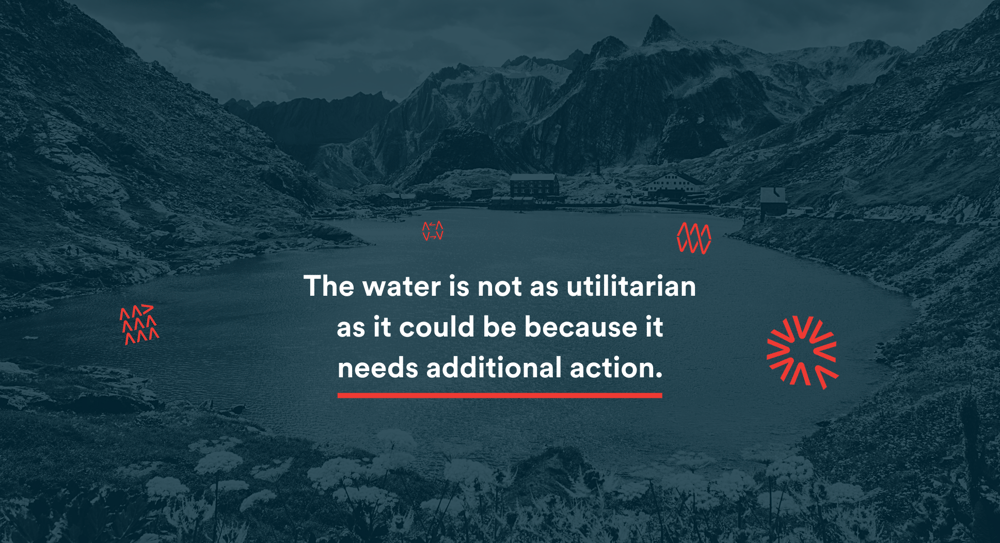software development | big data
On the surface, trying to parse the difference between data lakes versus data warehouses seems complex.
Both act as repositories of data collected by your organization. Both can be utilized for apps and programs and analytics that enable you to optimize your business processes. As such, it’s easy to get them confused.
But do you want to know a secret? The difference is actually really straightforward, and we’re going to provide the easiest data lake/data warehouse explanation you’ve ever heard to help you remember.
The Well Vs. The Source
Envision a lake. Not a data lake, just a regular old lake, filled with water. It draws its volume from the runoff of snow from the surrounding mountains. It’s filled with millions and millions of gallons of water.
But that water is unrefined. It’s in its natural condition. The water is not as utilitarian as it could be because it needs additional action.
What’s more, there are three other lakes in the mountains, none of which intermingle with each other. Each has its own source and provides a slightly different coloration and taste. And you want to be able to draw water from each of them.
Let’s imagine now that there’s an underground aquifer that runs from each lake, down beneath your cabin (Oh, by the way, you have a lakeside cabin in this scenario. Lucky you!). In order to benefit from those aquifers and prevent having to tramp all the way down to each lake with a bucket every time you need water, you dig out a well. Four wells, to be precise, so that you can pull from each lake.
Now, when you need water, you pump it from the wells and store it in barrels in your cellar. That water can now be used for numerous purposes. You have it for drinking, for cooking, for bathing, for filling up water balloons, for distillation, for growing crops, etc. The water can be stored for a long time, ready for you to interact with in specific ways. You can even combine the water from one lake with water from another to create something entirely new!

Okay, so you probably guessed the big twist ending: the water lakes were actually data lakes and the cellar is your data warehouse. Congratulations. You now know the difference between a data lake and a data warehouse.
Bringing Order to the Data Chaos
A data lake is data chaos. It’s a giant, seemingly endless source of information that, if you tried to reach the bottom, you could easily drown. It’s a daunting collection of details that can overwhelm business operations. Complicating matters further, you might encounter multiple lakes, each with disparate sources and types of data.
But a data warehouse brings order to that chaos. The warehouse is a cloud or server-based storage mechanism that provides limits and boundaries to the data. You’re not dipping from the source in a data warehouse; you’re dealing with the refined version of that data, organized in a way that makes it usable for business processes, with categorization delineated and usages defined. You’re combining data from different lakes in order to enhance business operations.
It’s the data warehouse that makes business intelligence run smoothly, because the warehouse sets the parameters on the data the same way pumping water and storing it in a cellar provides the foundation for that water’s subsequent usage.
The warehouse outlines what the data is to be used for and enables you to run analytics, populate forms and operate according to your needs and the needs of your customers. It stores the data for easy and immediate access, so that you’re not constantly forced to find and pull from the overwhelming lake of data. It provides takeaways only made possible through the combination of data from different lakes.
Choosing the Path of Least Resistance
In order to inform your business strategy and create successful data-based product offerings, you’ll probably need to utilize some combination of a data lake and a data warehouse. You’ll need the lakes to store the vast pool of data at your disposal (unless you’re acquiring this data from a third party, which is another process with its own set of challenges to explore). But you’ll also need a warehouse to enable you to craft your data plan and put together your solutions.
If you find yourself in need of creating a secure data warehouse or a data lake, or if you’re managing multiple data lakes and need to create a warehouse in order to become more efficient and operationalize the vast array of information at your disposal, let’s talk. We have experience setting up secure data lakes and warehouses and ensuring that information is easily transmissible, through encryption, to dashboards and predictive algorithms that display the information intuitively.


.png)


